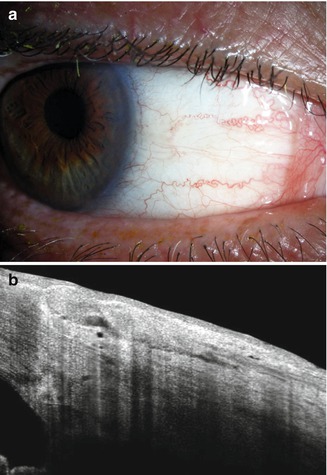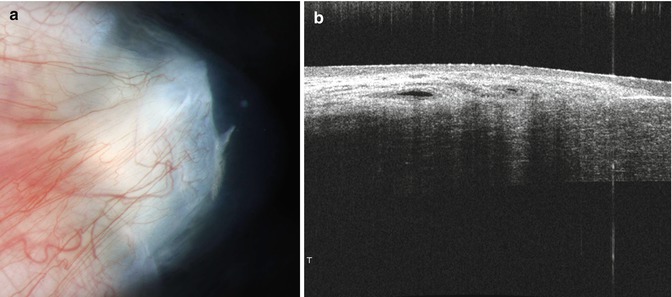Fig. 13.1
Conjunctival intraepithelial neoplasia. Clinical photograph (a) and optical coherence tomography (b). Note a hyper-reflective and thickened epithelium with an abrupt transition zone from abnormal to normal epithelium, consistent with ocular surface squamous neoplasia

Fig. 13.2
Pinguecula. Clinical photograph (a) and optical coherence tomography (b). Note a normal surface epithelium with underlying hyper-reflective, subepithelial mass, consistent with pinguecula

Fig. 13.3
Pterygium. Clinical photograph (a) and optical coherence tomography (b). Note a normal surface epithelium with underlying hyper-reflective, subepithelial mass
13.3.2 Confocal Microscopy
In vivo confocal microscopy can detect cellular anisocytosis and enlarged nuclei in conjunctival intraepithelial neoplasia. Confocal microscopy is a noninvasive technique for in vivo assessment of histology [3].
13.3.3 Ultrasound Biomicroscopy
Conjunctival lesions that adhere to the surrounding structures can be further assessed by high-frequency ultrasonography (Ultrasound biomicroscopy) to determine the depth of the tumor and its extension into the sclera and cornea or rarely into intraocular structures (Fig. 13.4).
 < div class='tao-gold-member'>
< div class='tao-gold-member'>





Only gold members can continue reading. Log In or Register to continue
Stay updated, free articles. Join our Telegram channel

Full access? Get Clinical Tree


